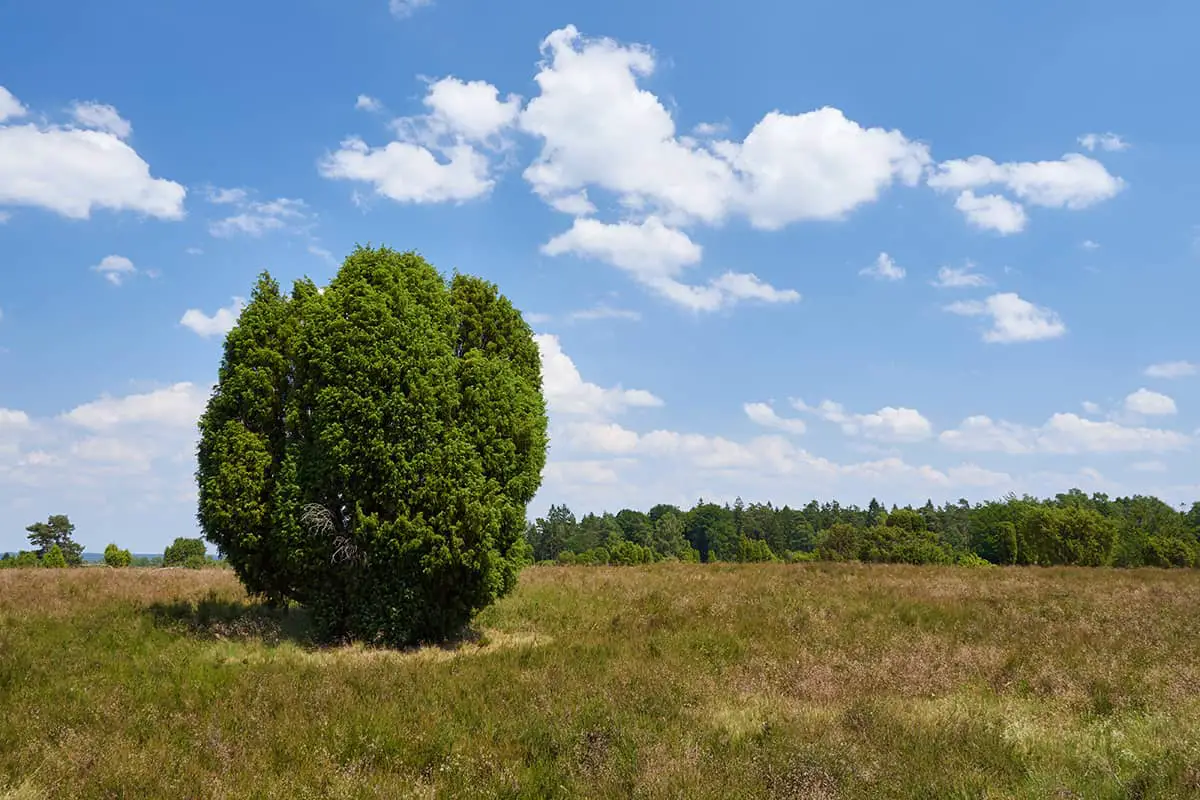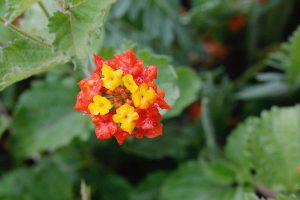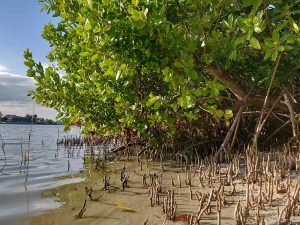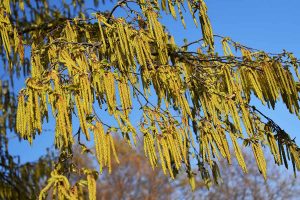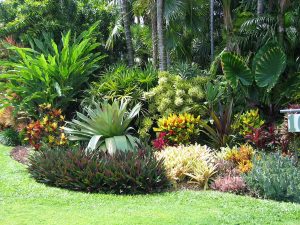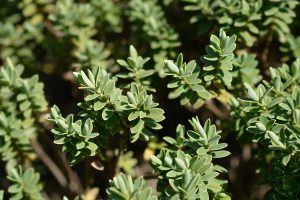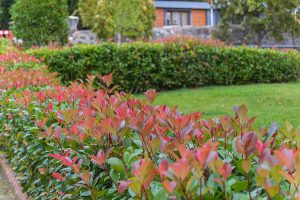Compact gardens don’t have to be limited to compact shrubs and trees. In fact, even if the square footage of your garden is quite small, there is typically no limit on height in gardens, so you can still benefit from a lush display of foliage, but it will be covering more vertical space rather than horizontal space.
This is where narrow shrubs can really shine because they add interest to a garden while also bringing an architectural, structured feel to the space. If you want to benefit from color and texture all year round, opt for evergreen shrubs with narrow growth patterns, as these will hold their foliage through every season while not taking up much ground space.
Here we look at some of the best narrow evergreen shrubs for growing in a wide range of climates and conditions.
Table of Contents
English Yew ‘Standishii’
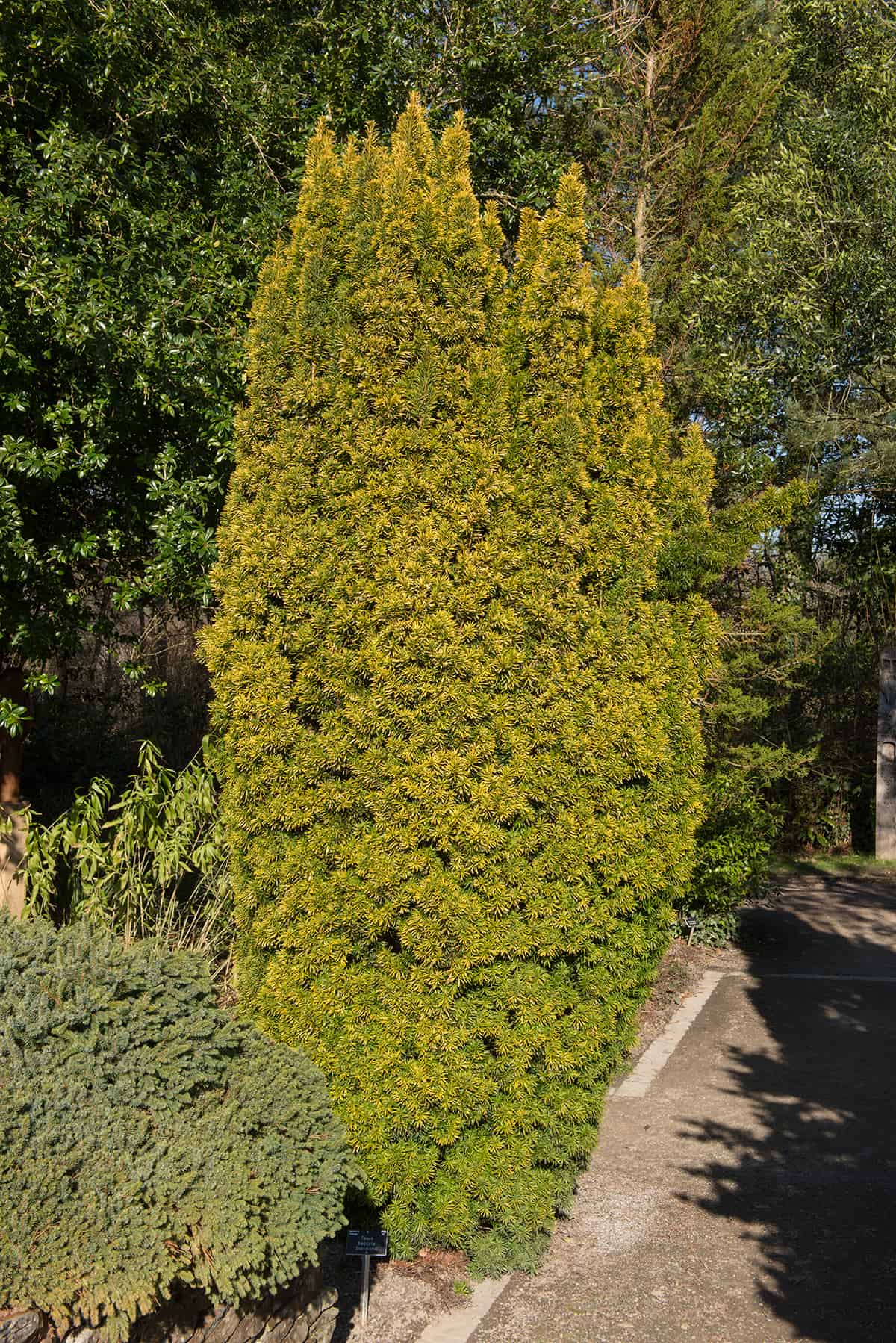
- Botanical name: Taxus baccata
- Family: Taxaceae
- USDA hardiness zones: 7- 8
- Mature height: 4 to 5 feet
- Mature spread: 1 to 2 feet
This evergreen shrub is native to Europe, as well as parts of Africa and Asia. It is incredibly compact, reaching a maximum of 2 feet in width. The densely packed branches are adorned with flat leaves in an attractive shade of golden yellow-green. The foliage retains its color all year round, providing appealing interest in the garden even through the winter months.
The shape of this plant provides structure to the landscape, creating a carefully pruned look with hardly any maintenance required at all. It is ideal for smaller gardens because it has an exceptionally slow growth rate of just 1 inch per year, meaning it will not outgrow its space for a long time.
The shrub can be grown in rows, at a distance of 30 inches between the center of each plant, to create a dense privacy screen or low hedge. The ‘Standishii’ variety of English Yew has received the Award of Garden Merit from the Royal Horticultural Society.
It grows best in full sun or partial shade and will adapt to a wide variety of soils. Its compact size means it works well in container planting and is also popular in rock gardens or as a specimen plant.
Arborvitae ‘Green Giant’
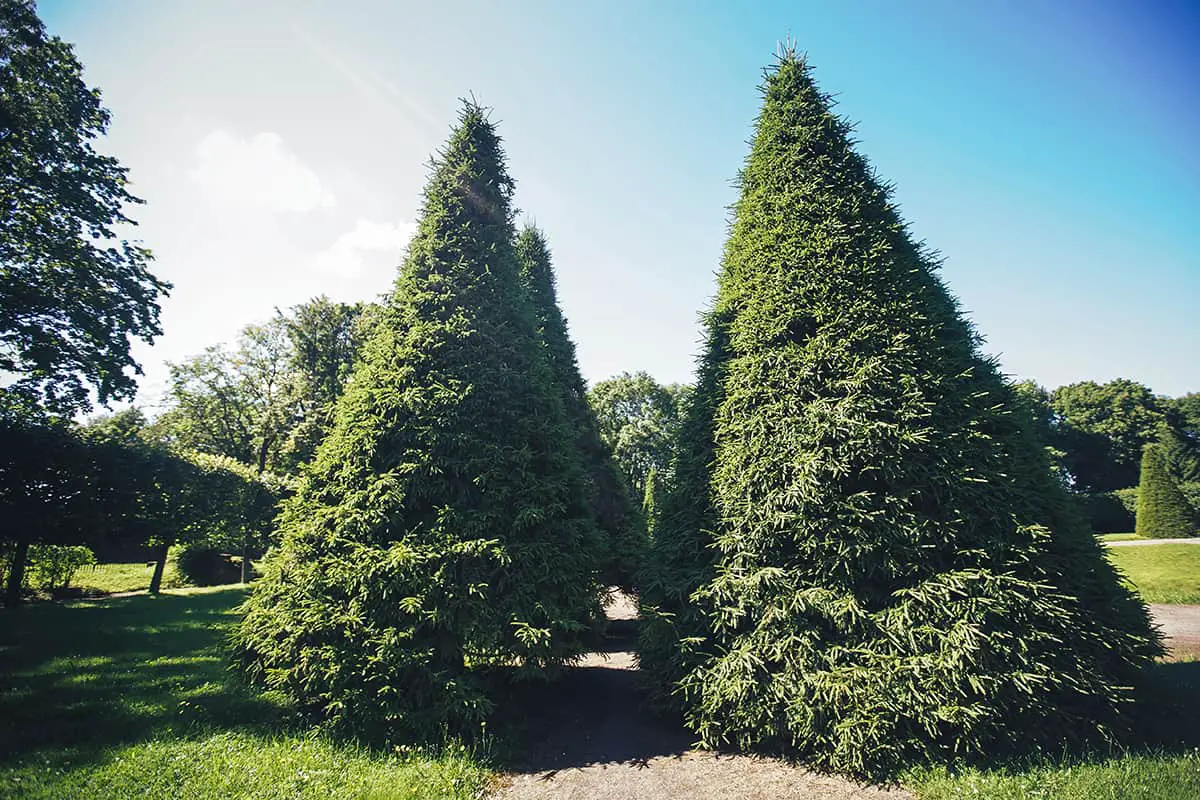
- Botanical name: Thuja standishii × plicata
- Family: Cupressaceae
- USDA hardiness zones: 5 – 8
- Mature height: 40 to 60 feet
- Mature spread: 12 to 18 feet
This narrow evergreen shrub is a hybrid that was created by crossing the Western Red Cedar with the Japanese Arborvitae in the 1930’s in Denmark. It arrived as a specimen in the United States in 1967. The shrub has a conical or pyramidal habit and deep emerald green foliage, which retains its color all throughout the year.
This plant has an exceptionally fast rate of growth, gaining up to 5 feet in height in a single year. This makes it an ideal choice of plant if you want to quickly benefit from a tall specimen, for example, to block out the view of a road or a neighboring property. It can be planted in rows to create a privacy screen or dense hedge.
The large yet narrow growth habit of the ‘Green Giant’ means it creates a dramatic exclamation point in the garden, adding architectural interest. This plant grows easily with very little maintenance. It performs best in full sun and prefers moist soil conditions. In high temperatures, it will benefit from some shade, and you should avoid allowing the soil to dry out since the ‘Green Giant’ cannot tolerate drought.
Japanese Euonymus ‘Green Spire’
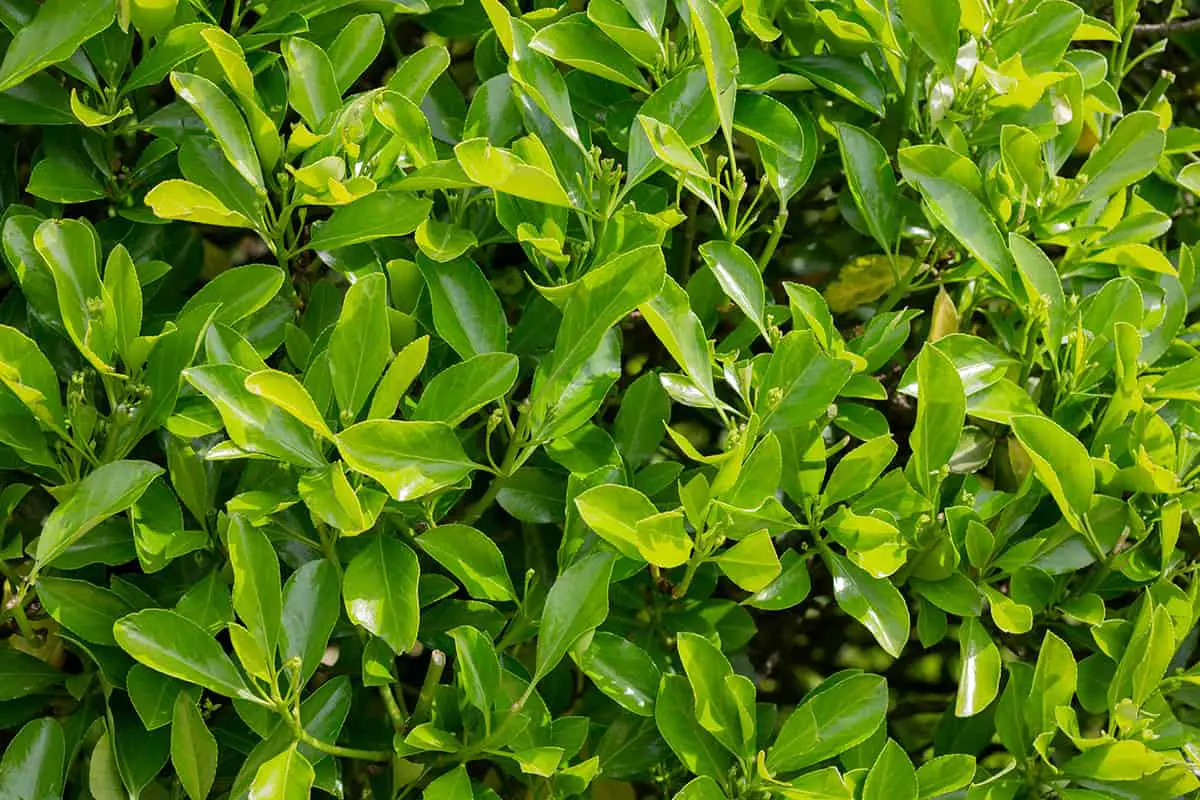
- Botanical name: Euonymus Japonicus
- Family: Celastraceae
- USDA hardiness zones: 6- 9
- Mature height: 6 to 8 feet
- Mature spread: 1 to 2 feet
This is an evergreen plant that can be grown as a large shrub or small tree. It is native to Asia and produces spoon-shaped foliage in a deep shade of green. The ‘Green Spire’ variety has a narrow growth habit, with erect branches which reach upwards. The branching and foliage of the shrub are dense, making this a suitable plant to use for privacy hedging.
It can reach up to 8 feet in height but typically grows to a width of between 1 and 2 feet and is, therefore, ideal for use in compact gardens where horizontal space is in short supply. It grows well in full sun or partial shade and is adaptable to a wide range of soil types, including clay, sandy, chalk, and poor soils.
Common Juniper ‘Compressa’
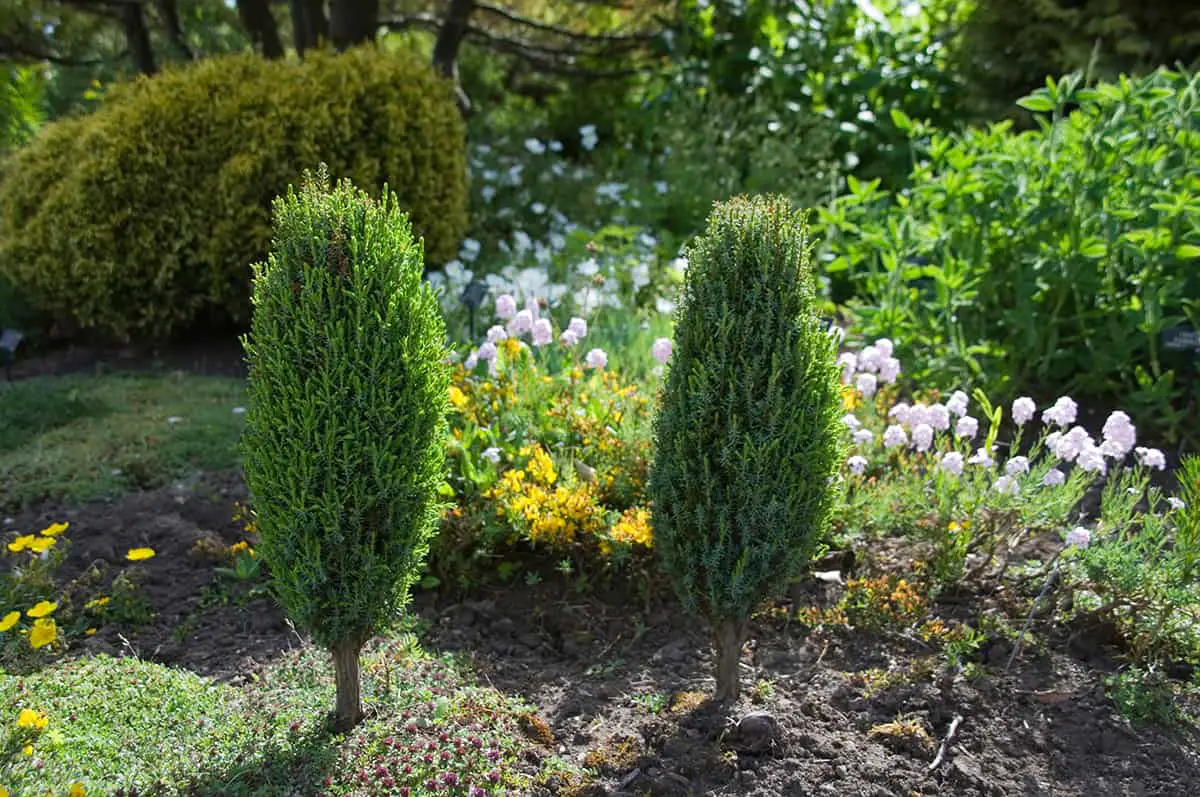
- Botanical name: Juniperus communis
- Family: Cupressaceae
- USDA hardiness zones: 2- 6
- Mature height: 2 to 3 feet
- Mature spread: 1 to 2 feet
This is a dwarf variety of Juniper, which has a narrow, column-shaped growth habit and a compact eventual height of under 3 feet. It is ideal for container planting due to its small size, but it also works well as a specimen plant in rock gardens or grown in rows to create a tidy, low border.
This is an evergreen shrub that has blue-green foliage densely packed onto the short branches. In winter, the foliage fades to an attractive shade of bronze. This is an award winning variety of Common Juniper, which adds a neat, architectural look to the landscape, and can be worked into a garden of almost any size.
It is exceptionally hardy down to USDA zone 2, and can therefore be grown in even the coldest of climates. It thrives in full sun, and is exceptionally low maintenance since it requires no pruning, is tolerant of most soil types, and can withstand drought once well established.
Japanese Holly ‘Sky Pencil’
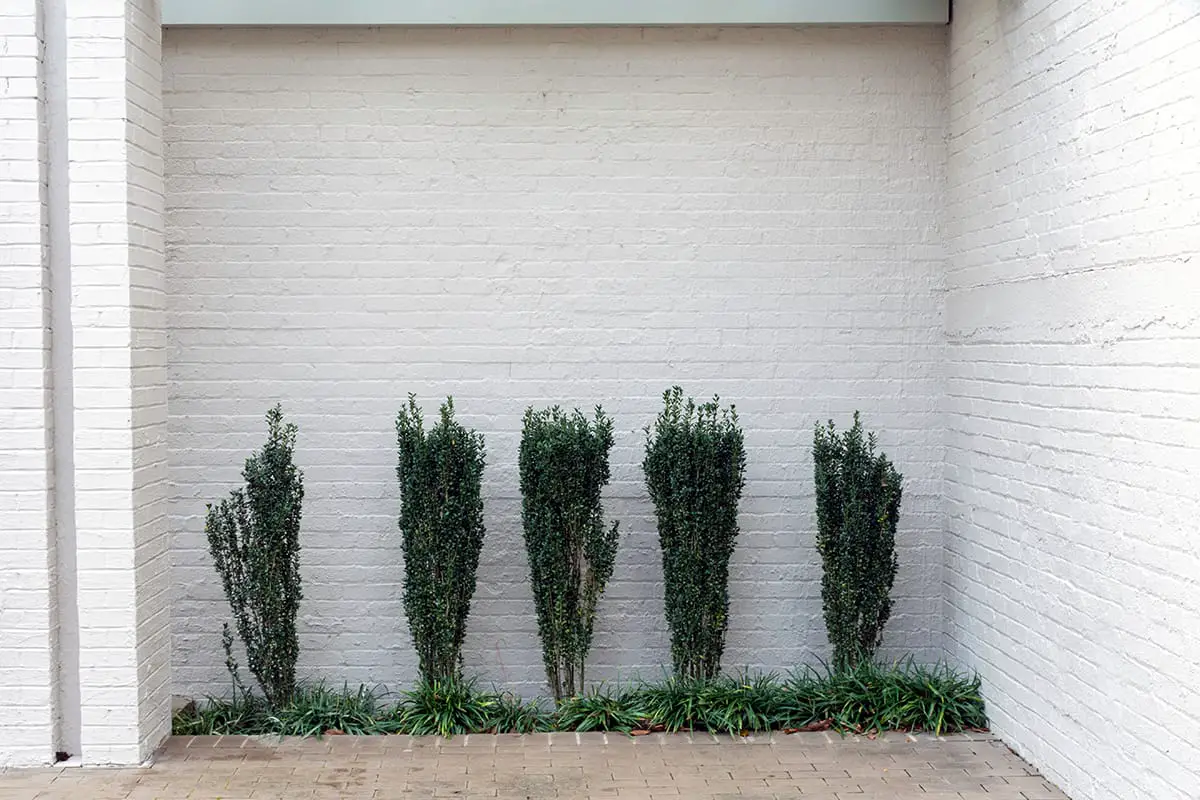
- Botanical name: Ilex Crenata
- Family: Aquifoliaceae
- USDA hardiness zones: 6- 8
- Mature height: 6 to 10 feet
- Mature spread: 1 to 3 feet
This evergreen shrub is native to Asia. It has a narrow, columnular shape and is well suited to growing in a diverse range of scenarios. It produces dark green foliage which is richly glossy, and these leaves hold their color throughout the year. The plant also produces small white flowers, which give way to tiny black berries towards the end of the year.
The ‘Sky Pencil’ is a female variety of Japanese Holly, and it will need to be cross-pollinated with a male variety of Holly in order for the flowers to develop into fruits. If you wish for your ‘Sky Pencil’ to reproduce, plant it close to a male variety of Holly. The slender growth habit of this shrub makes it an ideal specimen plant, but it can also be grown in rows to create a stylish hedge.
It does not need to be trained or pruned and therefore provides an excellent low-maintenance structure to the landscape. This plant loves to be grown in full sun or partial shade, and it will adapt to a wide range of soils, though it prefers moist soil, which is well-draining. Once mature, this plant can survive short periods of drought.
Lawson Cypress ‘Pinpoint Blue’
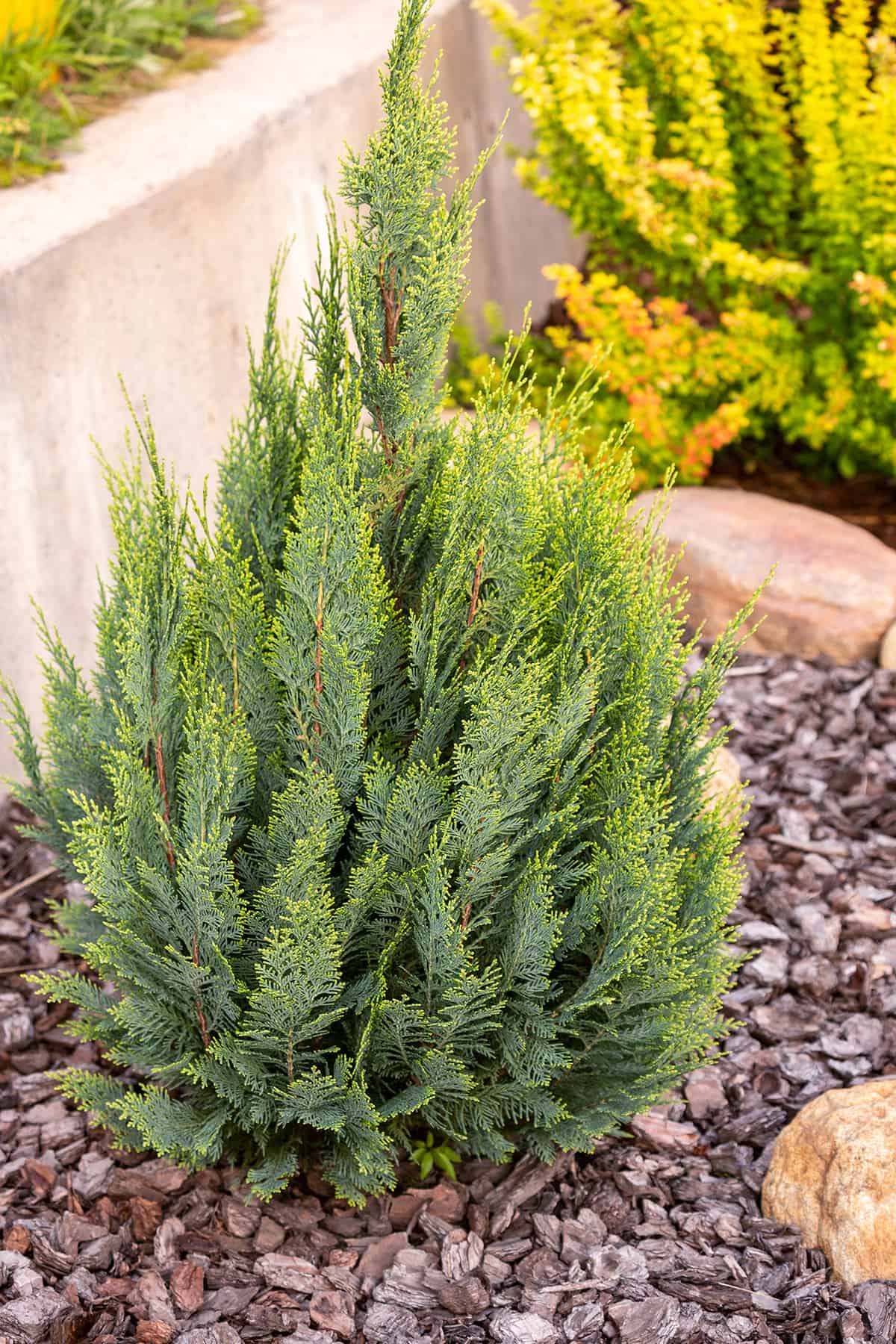
- Botanical name: Chamaecyparis lawsoniana
- Family: Cupressaceae
- USDA hardiness zones: 5- 7
- Mature height: Up to 20 feet
- Mature spread: 5 to 6 feet
This is an evergreen conifer that is native to the western US, both in Oregon and California. It takes the shape of a columnular, slightly pyramidal medium-sized shrub with feathery foliage that retains its color through every season. The sprays of foliage on the plant have a blue-green color, hence the name ‘Pinpoint Blue’.
This plant is perfect for small to medium gardens since it does not take up much width space in the soil, and it also works extremely well as a lush hedge when planted in rows. The shrub will reach maximum heights of up to 20 feet and can take up to 10 years to reach this size.
This variety of Lawson Cypress requires no pruning and will add structure to the landscape without any maintenance. It prefers full sun to partial shade and will grow easily in well-draining soils which are consistently moist.
Common Juniper ‘Gold Cone’
- Botanical name: Juniperus Communis
- Family: Cupressaceae
- USDA hardiness zones: 2- 6
- Mature height: 3 to 5 feet
- Mature spread: 1 to 2 feet
This variety of Common Juniper has an upright, narrow growth habit, which creates a neat exclamation point in the garden. It is an evergreen shrub that features soft feathery foliage densely packed onto the branches to create a very lush result. The foliage emerges as a bright shade of yellow-green in the spring, and this color remains throughout summer before it darkens to a deeper shade of golden yellow in the fall and through to winter.
Since the foliage of the shrub holds an interesting color throughout the seasons, it works well for providing an engaging visual in the landscape all year round. It is an extremely attractive specimen that can work well when grown in containers on a terrace or to add vertical interest in rock gardens.
This is a very hardy plant that will grow easily in a variety of conditions. It is tolerant of a wide range of soil and will survive extended periods of drought once mature.
Boxwood ‘Graham Blandy’
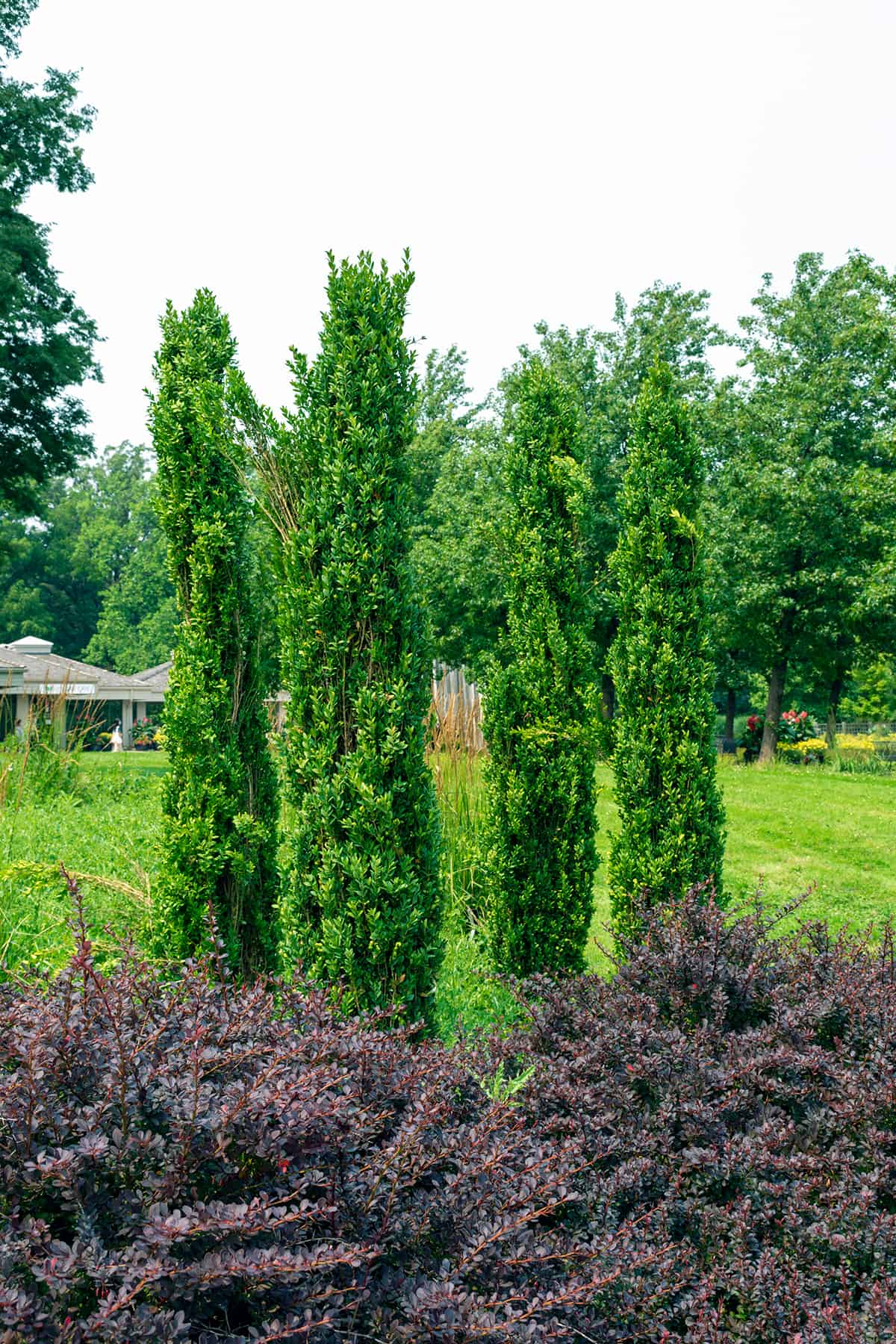
- Botanical name: Buxus sempervirens
- Family: Buxaceae
- USDA hardiness zones: 6 to 8
- Mature height: 5 to 15 feet
- Mature spread: 1 to 2 feet
This is an exceptional evergreen shrub that provides interest, color, and architectural structure to a landscape throughout every month of the year. It has an extremely narrow, slender growth habit, reaching heights of up to 15 feet while only spanning 1 to 2 feet in width. It is ideal for small gardens because it takes up extremely limited ground space, and it is also well suited for growing in containers.
The plant is also slow growing, so it will not quickly outgrow its spot in your garden. The foliage of the plant is lush and attractive. Each leaf is a small oval shape with a semi-glossy finish. The leaves start out light green and develop to a deep shade of green as they age. The branches of this plant grow in an upright habit, creating the impression that the shrub is reaching for the sky.
Foliage clothes the densely packed branches for a thick and luxurious-looking plant. This variety of Boxwood grows easily in most soil types, but it performs best when there is little sand or clay present. It prefers moist soils, though it can tolerate drought. In terms of light exposure, the Boxwood will thrive in partial shade.
It can withstand full shade, but the plant will have a considerably less dense look when it does not receive enough sunlight. The ‘Graham Blandy’ variety of Boxwood is named after Graham Blandy, who gifted 700 acres of land from his estate to the University of Virginia in 1924 in order for them to set up an experimental farm where students would be taught farming methods
Irish Yew ‘Fastigata Aurea’
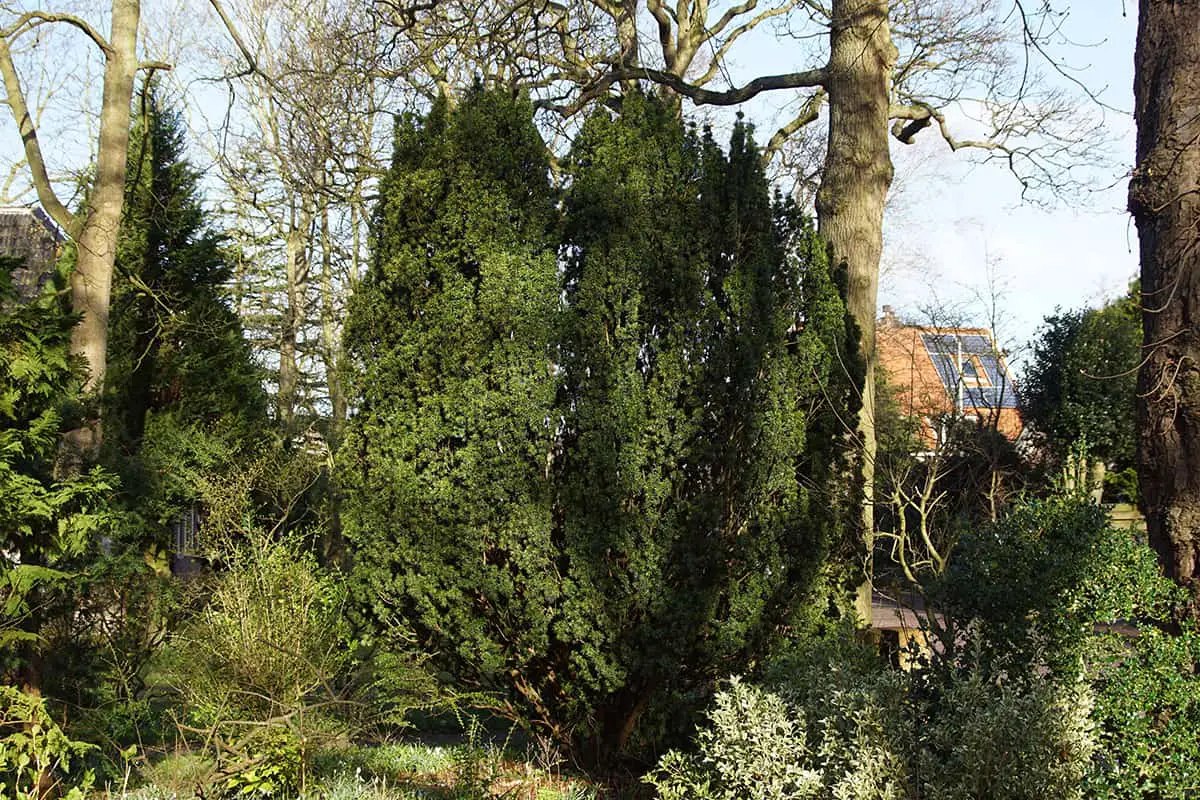
- Botanical name: Taxus baccata ‘Fastigiata’
- Family: Taxaceae
- USDA hardiness zones: 7- 8
- Mature height: 4 to 30 feet
- Mature spread: 2 to 8 feet
The Irish Yew is believed to be a result of a natural mutation of the Common Yew. It was first discovered in 1780 in County Fermanagh in Ireland, hence the name of Irish Yew. The shrub has a column-shaped growth habit, which can become more conical as the plant reaches maturity.
It will reach eventual heights of anywhere between 4 and 30 feet, growing at a rate of between 6 inches and 1 foot per year. The branches of this plant are erect and stiff, pointing up to the sky. They are covered in small needle-like foliage, which is a dark mossy green color. All parts of the plant are highly toxic to humans and animals, and so they should be kept away from pets and children who may investigate with their mouths.
The Irish Yew is adaptable to a wide range of soil types and lighting exposure. It thrives in full sun or partial shade, but it will also tolerate a fully shaded position.
